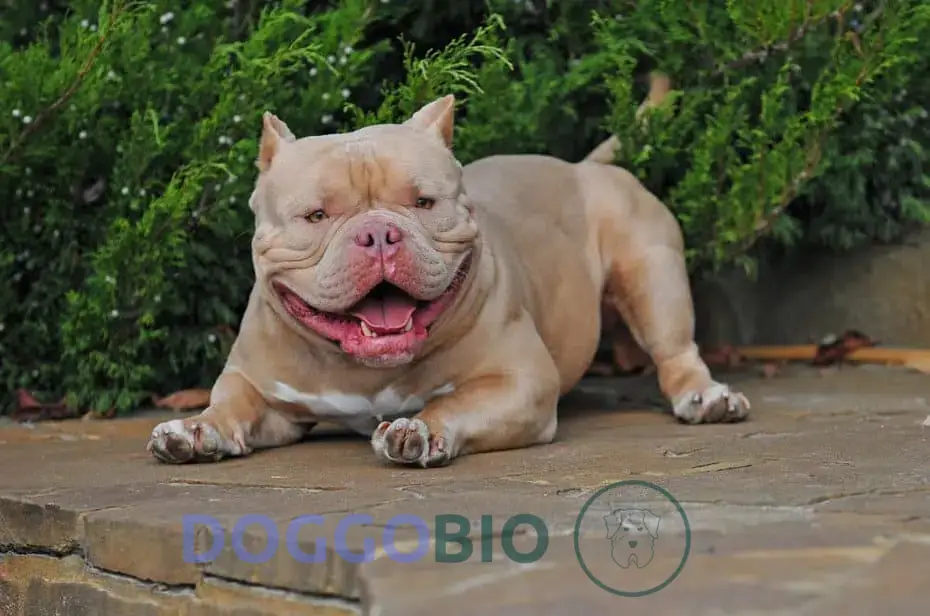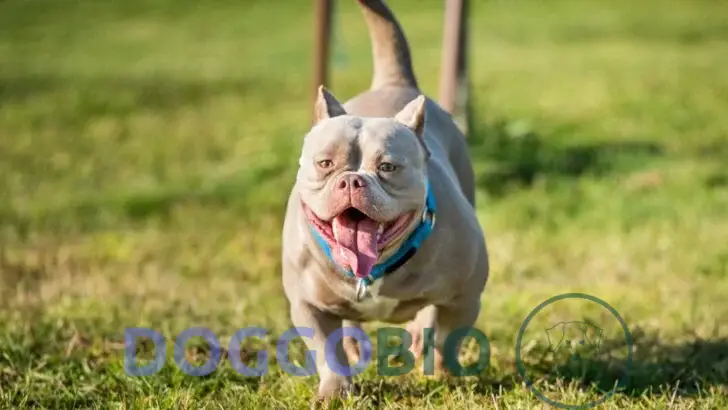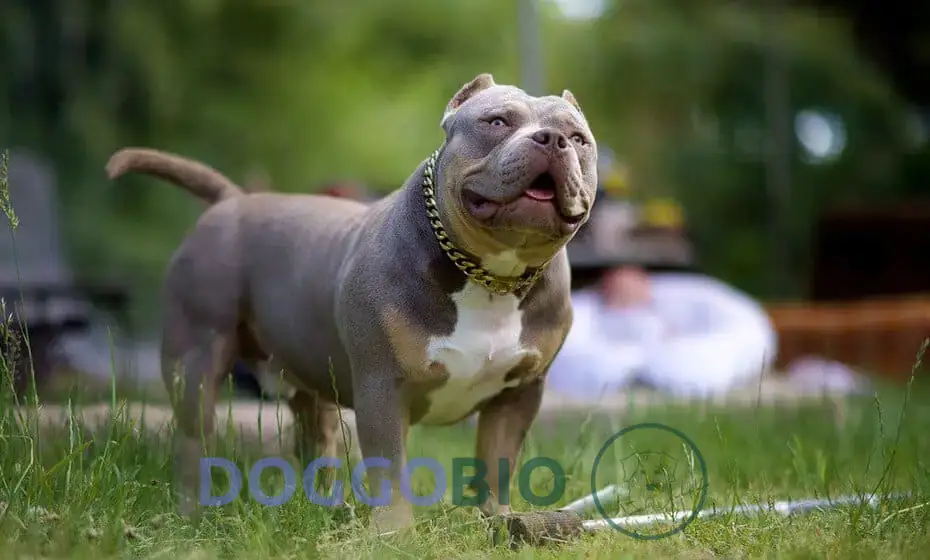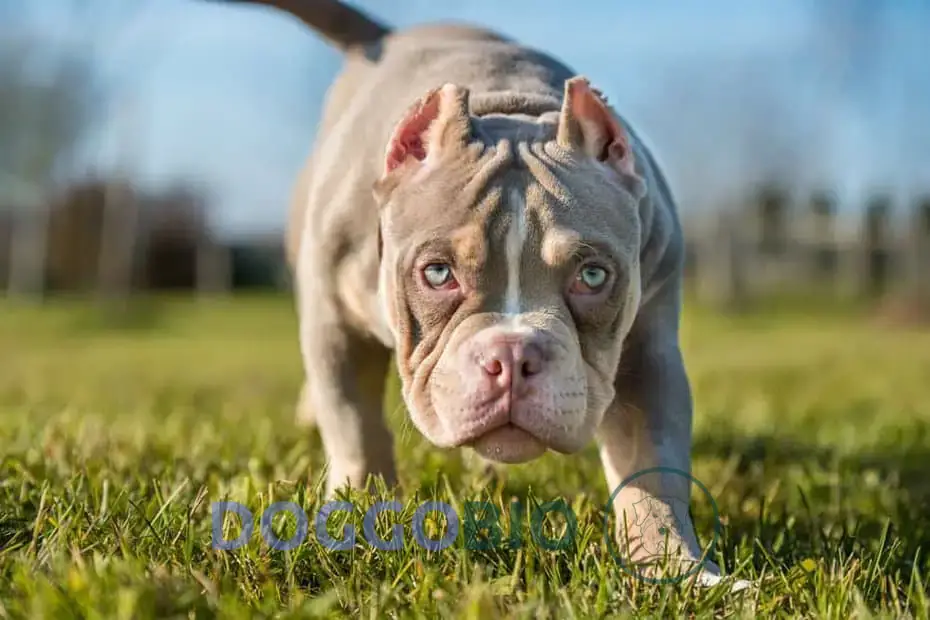The Pocket Bully, also known as the Pocket Pitbull, is a relatively new dog breed that has quickly gained popularity for its unique combination of size, temperament, and undeniable charisma.
Developed by selectively breeding American Pitbull Terriers and other smaller companion breeds, the Pocket Bully offers the perfect blend of loyalty, athleticism, and adaptability.
This article will explore the unique qualities that make the Pocket Bully an irresistible companion for individuals and families alike.
A Brief Overview of Micro Bully
| Breed group | Hybrid |
| Size | Small to medium-sized |
| Height | 12-17 inches |
| Weight | 10-25 pounds |
| Coat | Short fur with or without a wooly undercoat |
| Coat color | Varies (red, black, fawn, gray, or golden) |
| Vocal | Barks when necessary |
| Life span | 10-13 years |
| Temperament | Sweet, confident, and spirited |
| Hypoallergenic | No |
| Origin | United States |
What is a Pocket Bully?

The pocket bully, also known as the “micro bully” or “pocket pit bull,” has gained popularity as one of the many pit bull crosses in recent years.
It’s important to note that the pocket bully is not a purebred dog but rather a cross between the American Bully and the British Patterdale Terrier, resulting in this unique breed.
Despite not being recognized by organizations like the American Kennel Club and United Kennel Club, pocket bully owners, and breeders are actively working to increase the visibility and recognition of these dogs.
History of American Pocket Bully
In the 1990s, the American Bully was created through selective breeding of the American pit bull terrier and the English bulldog. This designer crossbreed was among the first all-American mixes, yet it has not received recognition from specific significant kennel associations, including the AKC.
On the other hand, the Patterdale terrier, a smaller breed popular in the United Kingdom, is less widely recognized in the United States. These terriers were bred initially for rating purposes. While not acknowledged by the AKC, the Patterdale terrier stands well with other—registries, such as the United Kennel Club and the National Kennel Club.
“Pocket bully” typically refers to crosses between the American Bully and the Patterdale terrier. However, some breeders use the term to describe smaller-than-average, “pocket-sized” American bullies.
What Does an American Pocket Bully Look Like?
Their small size and muscular physique characterize Pocket Bullies. They boast a stocky figure featuring a broad head, a prominent neck, and compact legs.
Typically, they have floppy ears, although they are often cropped. Their overall build is solid and robust, complemented by a medium-length tail.

Size, height, and Weight
Patterdale terriers are small dogs weighing between 11 and 13 pounds, while American bullies are medium-sized breeds weighing 35 to 75 pounds. Most pocket bullies consider the lighter end of the scale, typically between 10 and 25 pounds.
With their short legs and muscular build, these hybrid dogs inherit the physical traits of the standard Bully but in a smaller package.
Coat Colors and Types
In terms of coat, the pocket bully’s genetics determine whether they inherit the rough-coated Patterdale terrier’s wiry coat or the pit bull’s smooth single coat. Typically, micro-bull breeders prefer to breed smooth-coated Patterdale terriers with pit bulls, resulting in a consistent single coat type in the litter.
Micro bullies come in various colors, ranging from fawn to black. However, it’s worth noting that according to the UKC breed standard, white is not an accepted primary color for the Patterdale terriers, except for markings on the chest and paws. As a result, white is particularly rare in micro bullies, apart from those distinct chest marks.
Temperament and Personality
Pocket Bullies possess a sweet, affectionate, and loyal temperament. They are known for their gentle and friendly nature with their family and strangers while remaining alert and protective of their loved ones.
Unlike their larger counterparts, Pocket Bullies often escape the stereotypes and discrimination some breeds like Pitbull face. Their small size, though still muscular, exempts them from such misconceptions.
However, it’s important to note that these positive traits are not innate. Proper training and early socialization are crucial to prevent any behavioral issues. Refraining from neglecting training based on their size would be a mistake.
Training and Exercise Requirements

Micro Bully doesn’t require as much exercise as high-energy breeds as the Australian cattle dog. However, allocating at least 30 minutes to an hour daily for walking your pocket bully before committing to pet ownership is essential. Regular physical activity keeps them in good health and helps alleviate boredom and stress, which can lead to unwanted behaviors.
Regardless of breed, it’s essential to start training your pocket bully early for optimal results. Although pit bull breeds sometimes face unfair stereotypes, most have sweet temperaments and affectionate natures. Proper training and early socialization can reinforce these positive traits, reducing the likelihood of behavioral issues as they grow.
Grooming and Cleaning
- Pocket bullies typically have a smooth single coat that requires minimal grooming. Brushing your micro Bully at least once a week to distribute natural oils and maintain shiny, nourished skin is recommended.
- Bathing them once a month or as needed with a gentle, dog-friendly shampoo is also advised to preserve their coat’s health without stripping its natural oils.
- Did you know that 80% of dogs show signs of periodontal disease by age 3? Daily teeth brushing and regular dental cleanings, as suggested by your veterinarian, can significantly reduce the risk of this condition.
- Additionally, remember to trim your pocket bully’s nails as necessary to keep them at a comfortable length.
Food and Diet
Maintaining a well-balanced diet is essential for preventing obesity and other health issues in your pocket, Bully. Given their deep-chested nature, they are more prone to bloat. To mitigate this risk, consider dividing their daily portion into two meals instead of feeding them all at once.
It’s always advisable to consult your veterinarian to determine the healthiest diet tailored to your pocket bully’s specific needs, life stage, and potential health concerns.
As the pocket bully is a mixed breed, the amount of food they require daily can vary depending on the individual dog. Your vet will provide you with appropriate guidance in this regard.
Life Expectancy and Common Health Issues
Typically, Pocket Bullies have an average lifespan of 10 to 13 years.
Fortunately, Pocket Bullies, similar to most mixed-breed dogs, are generally healthy and enjoy relatively long lives.
However, like their parent breeds, they may experience specific health issues. They share concerns found in other compact dogs, such as French bulldogs. Here are some conditions to be aware of:
- Skin issues: Pit bulls, including pocket bullies, can be prone to skin problems like eczema, which may stem from various factors such as stress or food allergies.
- Brachycephalic airway syndrome: Like French bulldogs, pit bulls have a brachycephalic (short-nosed) structure, leading to breathing difficulties due to narrowed nostrils and airways.
- Hip dysplasia: While common in all canines, hip dysplasia can particularly affect larger or older dogs. When a dog has hip dysplasia, their hip socket doesn’t align correctly with the femur, potentially causing mobility issues if left untreated.
- Bloat: Deep-chested dogs like the pocket bully are susceptible to bloat, also known as gastric torsion. This life-threatening emergency occurs when the stomach distends and twists, requiring immediate veterinary attention.
How Much is a Pocket Bully?

The cost of a Pocket Bully typically begins around $2000. However, Pocket Bullies with unique bloodlines or special coat colors such as tricolor, Champagne (Lilac), blue fawns, or blue-nose variations can command significantly higher prices, up to $10,000. In some cases, exceptional puppies may even exceed these price ranges.
Type of dogs similar to the Pocket Bully:
If you’re still considering the pocket bully, it’s essential to thoroughly research and explore other breeds before deciding. Adopting a dog is a long-term commitment, so taking the time to consider your options is worthwhile. Here are a few species to start your exploration:
1. American Bully
The American Bully is the parent breed of the pocket bully. It emerged in the 1990s as a perfect combination of a companion and guardian. These gentle dogs possess a sweet temperament that suits family life well while retaining their protective instincts and loyalty to defend the home when necessary.
2. American Staffordshire Terrier
Recognized by the AKC, the American Staffordshire terrier is a pit bull breed known for the white mark on their chests. Weighing between 40 and 70 pounds, they are lighter than the American Bully but more significant than the pocket bully.
3. French Bulldog
Although unrelated, the compact French Bulldog bears a striking resemblance to the pocket bully. As one of the most popular breeds in the United States, French bulldogs are more readily available than the exotic micro Bully.
Is Pocket American Bully the Right Dog for You?
The Pocket Bully is a loving and gentle dog breed that can make a great family pet. However, training and socializing them early is essential to prevent territorial behavior. They thrive on human companionship, so if someone is in the house most of the time, a Pocket Bully can be a suitable choice for you.
List of dogs that are similar to Pocket Bully
Frequently Asked Questions
Is the Pocket Bully a Pitbull?
Yes, the Pocket Bully is classified as a Pitbull, albeit in a more minor form. It is a hybrid breed resulting from crossbreeding an American Bully and a Patterdale Terrier.
Does AKC recognize Pocket Bullies?
No, Pocket Bullies are not recognized by the American Kennel Club (AKC), but they are acknowledged by other organizations like the American Bully Kennel Club (ABKC) and the United Kennel Club (UKC).
The UKC, for example, recognizes certain variations of the American Bully but not all, including the Pocket Bully. This lack of recognition by the AKC means that Pocket Bullies cannot participate in AKC conformation competitions due to their mixed breed status.
Are Pocket Bully Dogs Aggressive?
No, Pocket Bullies are not inherently aggressive dogs. They are actually known for being affectionate, gentle, and good companions. While there may be individual cases where aggression is displayed, it’s typically due to factors like improper training or mistreatment by owners rather than inherent breed characteristics.
Do Bullies Shed A Lot?
Yes, Pocket Bullies do shed to some extent. While they have a short coat and are generally considered a low-shedding breed, they are not hypoallergenic. Allergies are typically triggered by dander, which can stick to their fur.
Regular brushing several times a week can help reduce shedding and minimize the amount of hair on your furniture and clothes.
Can American Bully give birth naturally?
Yes, American Bully dogs can give birth naturally, but some may need assistance.
While many American Bully dogs can breed naturally, those with extreme proportions might require assistance in mating. Some breeders resort to surgical or artificial insemination methods for breeding.
Moreover, due to their short noses and larger heads, cesarean sections are often chosen to ensure safe delivery, especially since natural birth can present challenges. Despite these considerations, Pocket Bullies generally have litters ranging from 2 to 5 puppies.
Are Pocket Bullies Good Pets?
Yes! Pocket Bullies are exceptional pets that bring joy to any household. They are a fantastic choice for young families and ideal companion dogs for older individuals and retirees.
Their small size, low grooming needs, and moderate exercise requirements make them easy to care for. Moreover, their loving and loyal nature makes them perfect companions for all.
Can Bully Swim?
Yes, Pocket Bullies can be taught to swim. While they may not be natural swimmers like Poodles or Retrievers, they can learn to enjoy the water with patience and training.
Their physical characteristics, such as a short snout and legs, along with a heavy neck and chest, can initially pose a challenge for swimming. To ensure their safety, it is recommended to use a dog life jacket when introducing them to water.
Start by introducing your Pocket Bully to the water in shallow areas, allowing them to become familiar with it at their own pace. Avoid forcing them into the water, as this can create a fear of water.
Support your dog in the water, preferably using a leash, to guide and assist them as they learn to swim. Gradually release the leash as they become more comfortable and confident in the water.
Conclusion
In conclusion, the Pocket Bully is a remarkable breed that defies expectations. Its compact size and muscular build are only matched by its gentle and affectionate nature.
Whether you’re seeking a loyal protector, a devoted friend, or a loving family pet, the Pocket Bully is ready to bring joy, companionship, and unwavering loyalty to your life. Embracing a Pocket Bully means embracing a powerful yet gentle soul that will forever leave paw prints on your heart.

Pingback: American Bully XL: Understanding Your Loyalty Companion 2024
Pingback: Exotic Bully Breeds: Unraveling Unique Canine Charisma 2024